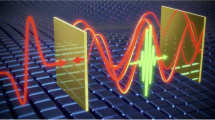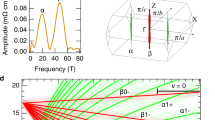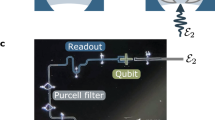Abstract
IN a recent communication1 Cook and Mallard have described a cavity 5 wave-lengths long for use with aqueous samples in an X-band spectrometer. Feher2 has shown that the highest sensitivity of such a spectrometer is obtained by maximizing the product of the filling factor ζ and the loaded Q of the cavity, this condition being fulfilled when the sample thickness is chosen so as to reduce the Q to two-thirds of its unloaded value. This value of reduction factor follows from three basic assumptions: (a) the cavity is of fixed length; (b) the sample is centred at a nodal plane of electric field; (c) it is always electrically thin. For a sample of fixed thickness there is no maximum in sensitivity as the cavity length is increased, the reduction in the proportion of the total electric field with which the sample interacts being balanced by a corresponding reduction in the interaction with the total magnetic field, so that when the increased power loss in the walls is taken into account, it is found that the filling factor decreases faster than the loaded Q increases.
This is a preview of subscription content, access via your institution
Access options
Subscribe to this journal
Receive 51 print issues and online access
$199.00 per year
only $3.90 per issue
Buy this article
- Purchase on SpringerLink
- Instant access to full article PDF
Prices may be subject to local taxes which are calculated during checkout
Similar content being viewed by others
References
Cook, P., and Mallard, J. R., Nature, 198, 145 (1963).
Feher, G., Bell Syst. Tech. J., 36, 449 (1957).
Stoodley, L. G., J. Electronics and Control (in the press).
Sogo, P. B., Carter, L. A., and Calvin, M., Free Radicals in Biological Systems (Academic Press, New York and London, 1961).
Author information
Authors and Affiliations
Rights and permissions
About this article
Cite this article
STOODLEY, L. Use of Long Cavities for Aqueous Samples in an Electron Spin Resonance Spectrometer. Nature 198, 1077 (1963). https://doi.org/10.1038/1981077a0
Issue date:
DOI: https://doi.org/10.1038/1981077a0
This article is cited by
-
Calculation of ESR signals and optimal sizes for paramagnetic specimens in ESR radio spectroscopy
Measurement Techniques (1973)
-
Use of slow-wave spirals in recording ESR spectra
Theoretical and Experimental Chemistry (1966)
-
Use of Long Cavities for Aqueous Biological Tissue Samples in an Electron Spin Resonance Spectrometer
Nature (1964)
-
Use of Long Cavities for Aqueous Samples in an Electron Spin Resonance Spectrometer
Nature (1963)



